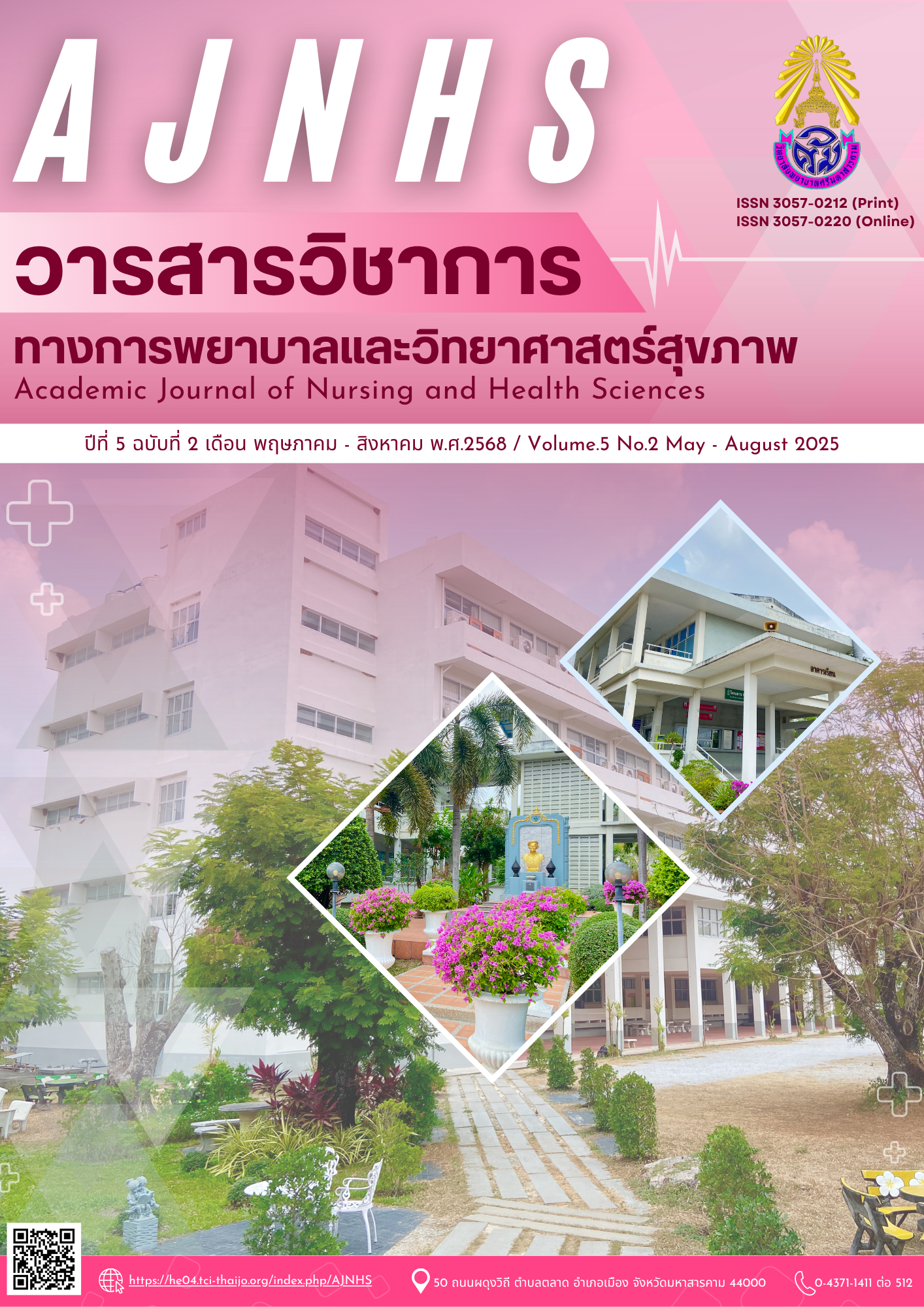การประยุกต์ใช้แนวคิดการส่งเสริมการจัดการตนเองในการพยาบาลผู้ป่วยวัยรุ่นโรคเบาหวานชนิดที่ 1 กรณีศึกษา
คำสำคัญ:
การจัดการตนเอง , การพยาบาล , ผู้ป่วยวัยรุ่น , โรคเบาหวานชนิดที่ 1บทคัดย่อ
โรคเบาหวานเป็นโรคไม่ติดต่อเรื้อรังที่พบบ่อยและเป็นปัญหาสุขภาพที่สำคัญทางสาธารณสุขทั่วโลก มีแนวโน้มของผู้ป่วยเพิ่มขึ้น โดยพบสถิติของการเกิดโรคเบาหวานชนิดที่ 1 ในเด็กและวัยรุ่นเพิ่มขึ้น ช่วงอายุที่ได้รับการวินิจฉัยครั้งแรกพบได้มากที่สุดในเด็กอายุน้อยกว่า 15 ปี ซึ่งส่งผลกระทบต่อผู้ป่วยเด็กและวัยรุ่นทั้งด้านร่างกาย จิตใจ อารมณ์ และสังคม การไม่สามารถควบคุมระดับน้ำตาลในเลือดให้อยู่ในเกณฑ์ที่เหมาะสม ทำให้เกิดผลกระทบทั้งแบบเฉียบพลันและเรื้อรัง และภาวะแทรกซ้อนต่อระบบอื่นๆ รวมทั้งส่งผลกระทบต่อครอบครัวของเด็ก เนื่องจากมีการดูแลที่ต่อเนื่อง มีค่าใช้จ่ายทางการแพทย์และการดูแลเด็กที่เพิ่มขึ้น ดังนั้นผู้ป่วยเด็กและวัยรุ่นจึงควรได้รับความรู้และการสนับสนุนการดูแลตนเองเพื่อนำไปสู่การปรับพฤติกรรมให้เหมาะสม ทั้งในเรื่องการควบคุมอาหาร การใช้ยาอินซูลิน การออกกำลังกาย การจัดการความเครียด จะช่วยชะลอการเกิดภาวะแทรกซ้อนในระยะยาวได้
บทความนี้ได้นำเสนอแนวทางการส่งเสริมการจัดการตนเองโดยศึกษาผ่านกรณีศึกษาผู้ป่วยเด็กวัยรุ่น โรคเบาหวานชนิดที่ 1 แนวคิดการจัดการตนเอง และแนวคิดของ Creer โดยส่งเสริมให้ผู้ป่วยมีส่วนร่วมในการตั้งเป้าหมายการดูแลตนเอง การเก็บรวบรวมข้อมูล การประมวลและประเมินข้อมูล การตัดสินใจ การลงมือปฏิบัติ และการสะท้อนตนเอง ซึ่งจะช่วยให้ผู้ป่วยมีความรู้ความเข้าใจ สามารถปรับเปลี่ยนการดำเนินชีวิตประจำวันให้เหมาะสม เพื่อให้สามารถควบคุมโรคด้วยตนเองได้อย่างต่อเนื่อง
เอกสารอ้างอิง
กนกวรรณ ด้วงกลัด, ปัญญรัตน์ ลาภวงศ์วัฒนา, และ ณัฐกมล ชาญสาธิตพร. (2563). โปรแกรมการส่งเสริมการจัดการตนเองในผู้ป่วยเบาหวานชนิดที่ 2 ที่ควบคุมไม่ได้. วารสารวิจัยสุขภาพและการพยาบาล, 36(1), 66–83.
กุลพิธาน์ จุลเสวก, อรุณรัตน์ อุทัยแสง, & ยุวนุช กุลาตี. (2566). ผลของนวัตกรรมแผ่นกำหนดจุดฉีดอินซูลินและแอพพลิเคชั่นไลน์ต่อความสามารถการใช้ยาฉีดอินซูลินชนิดปากกาและระดับน้ำตาลในเลือดของผู้ป่วยเบาหวาน. วารสารวิจัยสุขภาพและการพยาบาล วารสารวิทยาลัยพยาบาลบรมราชชนนี กรุงเทพ,
(2), 195–208.
งานเวชระเบียนและสถิติโรงพยาบาลศรีนครินทร์ คณะแพทยศาสตร์ มหาวิทยาลัยขอนแก่น. (2567). สถิติผู้ป่วยเด็กโรคเบาหวานชนิดที่ 1 ที่เข้ารับการรักษาในแผนกผู้ป่วยนอกระหว่างปี พ.ศ. 2564-2566. ขอนแก่น: โรงพยาบาลศรีนครินทร์ คณะแพทยศาสตร์ มหาวิทยาลัยขอนแก่น. ชดช้อย วัฒนะ. (2558). การสนับสนุนการจัดการตนเอง: กลยุทธ์เพื่อส่งเสริมการควบคุมโรค. วารสารวิทยาลัยพยาบาลพระปกเกล้า จันทบุรี, 26(1), 117-127.
ประพิมศรี หอมฉุย, ศิวิไลซ์ วนรัตน์วิจิตร, และ ชญานินท์ ประทุมสูตร. (2563). ผลของโปรแกรมการสนับสนุนการจัดการตนเองต่อพฤติกรรมการดูแลตนเองและระดับน้ำตาลในกระแสเลือดในผู้ป่วยเบาหวานชนิดที่ 2. วารสารวิทยาลัยพยาบาลบรมราชชนนี อุตรดิตถ์, 12, 204-254.
พลอยประกาย ฉลาดล้น, พิมพ์ลดา อนันต์สิริเกษม, และ วิภา กลิ่นจำปา. (2566). ผลของการสนับสนุนการ จัดการตนเองต่อพฤติกรรมการควบคุมระดับน้ำตาลในเลือดในผู้ป่วยโรคเบาหวานชนิดที่ 2. วารสารพยาบาลกระทรวงสาธารณสุข, 33(1), 90–101.
ภูเบตร พัฒนากร. (2565). ประสิทธิผลของโปรแกรมการสนทนาสร้างแรงจูงใจในพยาบาลต่อความรู้และพฤติกรรมการดูแลสุขภาพตนเอง ในผู้ป่วยโรคเบาหวาน. ยโสธรเวชสาร, 24(1), 106-115.
ราชวิทยาลัยอายุรแพทย์แห่งประเทศไทย ในพระบรมราชูปถัมภ์, สมาคมโรคเบาหวานแห่งประเทศไทย ในพระบรมราชูปถัมภ์สมเด็จพระเทพรัตนราชสุดา สยามบรมราชกุมารี, สมาคมต่อมไร้ท่อแห่งประเทศไทย, กรมการแพทย์ กระทรวงสาธารณสุข, และ สำนักงานหลักประกันสุขภาพ. (2566). แนวทางเวชปฏิบัติ
สำหรับโรคเบาหวาน 2566. กรุงเทพฯ: ศรีเมืองการพิมพ์.
สมาคมโรคเบาหวานแห่งประเทศไทย. (2567). แนวทางการพัฒนาเพื่อมาตรฐานคลินิกเบาหวาน. กรุงเทพฯ: ศรีเมืองการพิมพ์.
สาธิมา สุระธรรม, และ พรศรี ศรีอัษฎาพร. (2564). การให้ความรู้และสนับสนุนช่วยเหลือเพื่อการจัดการตนเองของผู้เป็นเบาหวาน: กรณีศึกษาวัยรุ่นเบาหวานชนิดที่ 1. วารสารพยาบาลสภากาชาดไทย,14(2), 25-36.
Cato, A., & Hershey, T. (2016). Cognition and type 1 diabetes in children and adolescents. Diabetes Spectrum, 29(4), 197–202.
Creer, T. (2000). Self-management of chronic illness. In M. Boekaerts, P. R. Pintrich, & M. Zeidner (Eds.), Handbook of self-regulation (pp. 601-629). California: Academic.
Creer, T. L., & Holroyd, K. A. (1997). Self-management. In A. Baum, C. McManus, S. Newman, J. Weinman, & R. West (Eds.), Cambridge handbook of psychology, health, and behavior (pp. 255-258). Cambridge: Cambridge University Press.
Dejkhamron, P., Santiprabhob, J., Likitmaskul, S., Deerochanawong, C., Rawdaree, P., Tharavanij, T., et al. (2022). Young-onset diabetes patients in Thailand: Data from Thai type 1 diabetes and diabetes diagnosed age before 30 years registry, care and network
(T1DDAR CN). Journal of Diabetes Investigation, 13(5), 796–809.
Duffus, S. H., Cooper, K. L., Agans, R. P., & Jain, N. (2019). Mental health and behavioral screening in pediatric type 1 diabetes. Diabetes Spectrum, 32(2), 171–175.
Greenwood, D. A., Gee, P. M., Fatkin, K. J., & Peeples, M. (2017). A systematic review of reviews evaluating technology-enabled diabetes self-management education and support. Journal of Diabetes Science and Technology, 11(5), 1015–1027.
International Diabetes Federation. (2021). IDF diabetes atlas. 10th edition. [Electronic version]. Retrieved October 10, 2024, from https://www.diabetesatlas.org
International Diabetes Federation. (2022). Type 1 diabetes estimates in children and adults. [Electronic version]. Retrieved October 10, 2024, from https://diabetesatlas.org/atlas/t1d-index-2022/
Kim, J. E. (2022). Illness experiences of adolescents with type 1 diabetes. Journal of Diabetes Research, 2022(1), 1–10.
Kimbell, B., Lawton, J., Boughton, C., Hovorka, R., & Rankin, D. (2021). Parents’ experiences of caring for a young child with type 1 diabetes: A systematic review and synthesis of qualitative evidence. BMC Pediatrics, 21(1), 160. https://doi.org/10.1186/s12887-021-02569-4
Pironetti, R., Saha, M. T., Luukkaala, T., & Keskinen, P. (2023). Sociodemographic factors affecting glycaemic control in Finnish paediatric patients with type 1 diabetes. Endocrinology Diabetes & Metabolism, 6(6), 1-11.
Rewolinski, J. A., Kelemen, A., & Liang, Y. (2020). Type I diabetes self-management with game-based interventions for pediatric and adolescent patients. Computers Informatics Nursing CIN, 39(2), 78–88.
Wisting L, Bang L, Skrivarhaug T, Dahl-Jørgensen K, Rø Ø. (2021). Psychological barriers to optimal insulin therapy: more concerns in adolescent females than males. BMJ Open Diabetes Res Care, 4(1), 1-7.
Xu, T., Pujara, S., Sutton, S., & Rhee, M. (2018). Telemedicine in the management of type 1 diabetes. Preventing Chronic Disease, 15(January), 1-9.
ดาวน์โหลด
เผยแพร่แล้ว
รูปแบบการอ้างอิง
ฉบับ
ประเภทบทความ
สัญญาอนุญาต

อนุญาตภายใต้เงื่อนไข Creative Commons Attribution-NonCommercial-NoDerivatives 4.0 International License.


